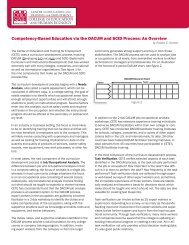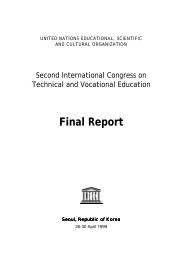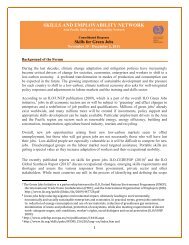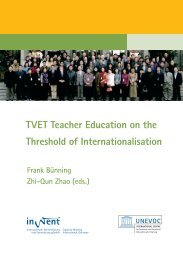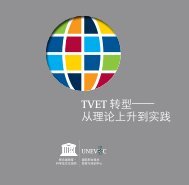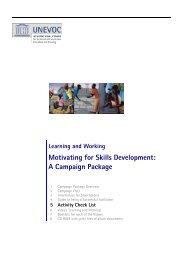Corporate HRD and Skills Development for ... - Unesco-Unevoc
Corporate HRD and Skills Development for ... - Unesco-Unevoc
Corporate HRD and Skills Development for ... - Unesco-Unevoc
You also want an ePaper? Increase the reach of your titles
YUMPU automatically turns print PDFs into web optimized ePapers that Google loves.
According to Glover (1992), industry-based skill assessment <strong>and</strong> certification should (1) be<br />
independent of training providers; (2) use a variety of instruments; (3) recognize multiple<br />
levels of mastery; (4) promote broad training <strong>and</strong> continuous learning; (5) be geared toward<br />
high-per<strong>for</strong>mance work organizations; (6) be voluntary; <strong>and</strong> (7) be flexible in order to keep<br />
pace with technological developments.<br />
The Benefits of Having <strong>Skills</strong> St<strong>and</strong>ards<br />
Skill st<strong>and</strong>ards have emerged from a belief that technology <strong>and</strong> market shifts have caused<br />
major changes in the skills <strong>and</strong> behaviours needed by the labour market (Bailey & Merritt,<br />
1995). They presented sound arguments <strong>for</strong> improving the system of skill st<strong>and</strong>ards <strong>and</strong><br />
certification. These included employer identification of qualified workers, reduced application<br />
screening costs, recruitment support, <strong>and</strong> overall improved public perception of credentialing<br />
organizations.<br />
An improved set of skill st<strong>and</strong>ards would provide students with a benchmark of relevant<br />
knowledge <strong>and</strong> skills, <strong>and</strong> the motivation <strong>for</strong> attaining them. Other advantages of a national<br />
system <strong>for</strong> graduates would include improved access to a national labour market <strong>and</strong> promotion<br />
of geographic mobility. Students, employers, <strong>and</strong> the general public are then better able to<br />
evaluate education <strong>and</strong> training providers. Increased accountability of workers, <strong>and</strong> meeting<br />
the needs of business <strong>and</strong> industry, are also believed to result from the implementation of skill<br />
st<strong>and</strong>ards (Bailey & Merritt, 1995).<br />
According to Boesel et al. (1994), the skills st<strong>and</strong>ards are useful in addressing the increase<br />
in labour mobility <strong>and</strong> movement between occupations. The skill st<strong>and</strong>ards also lead to more<br />
internal promotion by building career ladders within companies by using skill st<strong>and</strong>ards<br />
levels. Students are able to see concrete relationships between what they are learning in school<br />
<strong>and</strong> the actual jobs in the market. This prompts some lower level achievers to concentrate<br />
more on their schoolwork.<br />
Faulkner (2002) describes skill st<strong>and</strong>ards as meritorious in articulating the skills <strong>and</strong><br />
knowledge required by front-line workers in high-per<strong>for</strong>mance environments. It also serves as<br />
a benchmark that employees <strong>and</strong> employers can use to sustain a competitive edge. An advocate<br />
of skill st<strong>and</strong>ards <strong>and</strong> an active member in the national skill st<strong>and</strong>ards movement, Spill (2002)<br />
identifies multiple benefits to multiple stakeholders. The benefits to employers include<br />
enhancing their ability to communicate knowledge <strong>and</strong> skill per<strong>for</strong>mance requirements to<br />
new <strong>and</strong> incumbent employees <strong>and</strong> thereafter determine proficiency levels. They can also<br />
reduce the costs <strong>and</strong> risks associated with hiring new workers, while at the same time<br />
promoting existing employees. Individual employees <strong>and</strong> students benefit by being able to<br />
make in<strong>for</strong>med decisions about financial resources <strong>for</strong> education <strong>and</strong> training. They can better<br />
communicate their skills <strong>and</strong> knowledge to current <strong>and</strong> potential employers.<br />
Providers of education <strong>and</strong> training benefit because they can adapt course content which<br />
prepares graduates with the most current knowledge <strong>and</strong> skills necessary to meet the<br />
22



